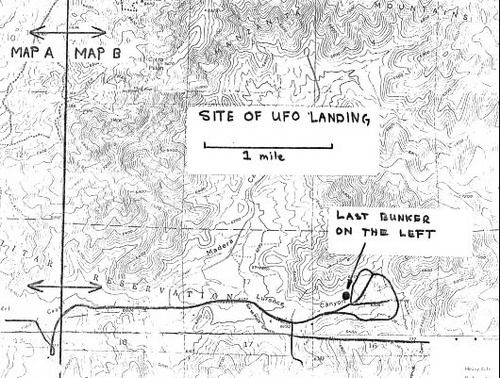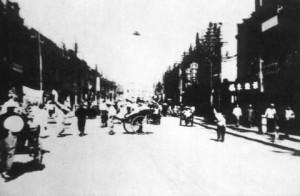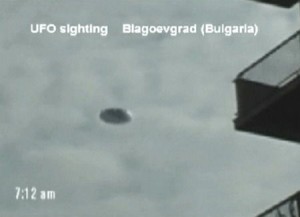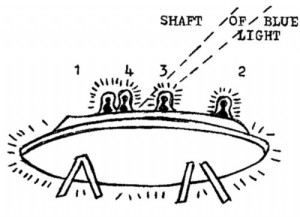Warning: strlen() expects parameter 1 to be string, array given in /home2/orbman69/public_html/wp-includes/functions.php on line 262
(Last Updated On: )
THINK ABOUTIT SIGHTINGS REPORT
Date: August 9, 1980 and other Dates
Location: Kirtland AFB, Albuquerque, New Mexico
Hynek Classification:
Duration:
Shape of Object(s): Disc
Number of Witnesses:
Source: Francis Ridge, NICAP Source
Summary: On the morning of August 9, 1980, several security guards at the Manzano Weapons Storage Area, adjacent to Kirtland AFB, saw a bright light descend in (a) restricted area. A fourth guard observed a disk shaped light in the vicinity of a bunker used to store nuclear weapons. The incident resulted in a report being filed with the Air Force Office of Special Investigations (AFOSI) at Kirtland.
Full Report
[The in-depth report of this case by Dr. Bruce Maccabee] has far-reaching implications if true, especially in light of what has been reported before at and near, Kirtland AFB, a military base which is one of the most sensitive military installations in the world.
On the morning of August 9, 1980, several security guards at the Manzano Weapons Storage Area, adjacent to Kirtland AFB, saw a bright light descend in (a) restricted area. A fourth guard observed a disk shaped light in the vicinity of a bunker used to store nuclear weapons. The incident resulted in a report being filed with the Air Force Office of Special Investigations (AFOSI) at Kirtland. The incident was subsequently investigated by agent Richard Doty — an interesting and mysterious figure who often appears in the UFO literature. Doty filed a preliminary report on the incident, which has been acknowledged and released by the Air Force. Researcher Bruce Maccabee’s question is, where is the follow-up report? Surely, no such incident at an atomic facility, even if explainable by mundane causes, would not have been further investigated. Maccabee reveals strong circumstantial evidence that such a report exists but is being withheld by the Air Force.
Francis Ridge, NICAP
Area 51 and Wright-Patterson AFB are perhaps the best known Air Force installations with connections to the subject of UFOs. but they are by no means the only ones. The UFO incidents that have occurred at or near Kirtland AFB, near Albuquerque, New Mexico, seem to have been ignored by mainstream UFOlogy.
In 1945, in southern New Mexico, at Los Alamos Laboratories, scientists were developing and testing the first nuclear weapons in great secrecy. The need for extensive flight support and test facilities reasonably near Los Alamos became apparent, and during September 1945, units of the Z Division of Los Alamos Laboratory were moved to Sandia Base at Albuquerque. The unit was the predecessor of Sandia Corporation, which was organized in 1949. It became, and (as Sandia National Laboratories) remains, the largest resident unit on Kirtland and has consistently been involved with development and testing of special weapons and energy sources and systems. Today this includes LASER weapons, particle beams, and plasma weapons – “Star Wars” weapons.
Other nuclear-related units were formed at Sandia Base and nearby Kirtland AFB, as the west side was redesignated in 1947. The Armed Forces Special Weapons Project (later the Defense Atomic Support Agency, then the Defense Nuclear Agency) operated Sandia Base and provided support to the Secretary of Defense, Joint Chiefs of Staff, and military departments in matters concerning nuclear weapons, nuclear effects, and testing. In addition, the Air Force Special Weapons Command was established at Kirtland in 1949 and was redesignated the Air Force Special Weapons Center in 1952 to help develop advanced nuclear weapons.
During the 1940s and 1950s, air defense, weather, and atomic test squadrons operated form Kirtland, and people from both bases took part in the 12 nuclear test series conducted in Nevada and the Pacific. Special Weapons Center biophysicists flew through nuclear clouds to determine radiation hazards, and its engineers launched sounding rockets to study the effects of high altitude nuclear explosions and to explore the Van Allen radiation belts surrounding the earth.
The Project Bluebook “unexplained” list compiled by Don Berliner from the Project files themselves contains several UFO sightings made in and around Albuquerque – Kirtland/Sandia in the early 1950’s:
Albuquerque, New Mexico
24 February 1950
1:55 p.m.
Witnesses: Municipal Airport Weather Observers Luther McDonald, Harrison Manson.
One white, slightly elongated oval was watched for 1.5 minutes through a theodolite while it flew straight and level.
Albuquerque, New Mexico
25 August 1951
9:58 p.m.
Witnesses: Sandia Base Security Guard Hugh Young and wife.
A flying wing-shaped craft passed over their heads at an estimated 800-1,000′ altitude with no sound. Size estimated at 1.5 times wingspan of B-36 bomber,or 350′. Dark, chordwise stripes on underside, and 6-8 pairs of soft, glowing lights on trailing edge of “wing”. Speed estimated at 300-400 m.p.h., object seen for about 30 seconds.
Albuquerque, New Mexico
28 May 1952
1:45-2:40 p.m.
Witnesses: Two city fire department employees.
Two circular objects–one shiny silver and the other orange or light brown– were seen three times performing fast maneuvers.
Albuquerque, New Mexico
5 June 1952
6:45 p.m.
Witness: S/Sgt T.H. Shorey.
One shiny round object flew 5-6 times as fast as an F-86 jet fighter for 6 seconds.
Albuquerque, New Mexico
7 June 1952
11:18 a.m.
Witnesses: Crew of B-25 bomber #8840 at 11,500′. One rectangular aluminum object, about 6’x4′, flew 250-300′ below the B-25.
Albuquerque, New Mexico
8 June 1952
10:50 a.m.
Witnesses: Mr. and Mrs. J.D. Markland.
Four shiny objects flew straight and level in a diamond formation.
Kirtland AFB, New Mexico
26 July, 1952
12:05 a.m.
Witness: Airman lst Class J.M. Donaldson.
Eight to ten orange balls in a triangular or V-formation flew very fast for 3-4 seconds.
Albuquerque, New Mexico
27 November 1952
12:10 p.m.
Witnesses: Pilot and crew chief of UAAF B-26 bomber.
A series of black smoke bursts (4-3-3-4-3), similar to antiaircraft fire, was seen over a 20 minute period.C. 12:30 a.m.
Witnesses: radar
This famous sighting occurred in 1957:
Kirtland Air Force Base, New Mexico
4 November, 1957
2245 MST
Witnesses: FAA(CAA) tower personnel, R.M. Kaser and E. G. Brink, reliable observers with 23 years of airport tower control experience between them.
Weather: Light rain.
A lighted object came down steeply at the east end of runway 26, left the flight line, crossed runways, taxiways, and unpaved areas at about a 30 degree angle, and proceeded southwest towards the control tower at an altitude of less than 100 feet. Observed through through 7x binoculars, the object appeared to be eggshaped, having no wings, tail, or fuselage, and was elongated vertically. It appeared to be fifteen to twenty feet tall, about the size of an automobile standing on its nose, and had a single white light at its base. Both Kaser and Brink emphatically stated that the object in no way resembled an aircraft.
When the object was about 3000 feet ENE of the tower, it stopped completely and hovered for about a minute. Then it began moving again, slowly at first, but then suddenly climbing at an extremely rapid rate of speed until it disappeared into the overcast sky. The object was in clear view at all time, with no intervening obstructions, according to the two men.
At this point Kaser and Brink phoned the CAA Radar Approach Control(RAPCON) unit to ask them if they could detect a fast target to the east. RAPCON was using CPN-18 surveillance radar at that time. Radar showed that the target moved eastward, then turned south at very high speed until it reached the vicinity of the Albuquerque Low Frequency Range Station, where it circled for several minutes. Then it came back towards Kirtland until it took up a position behind an Air Force C-46 that had just taken off. It stayed in position behind the C-46 until they both moved out of radar range.
In 1958, the U.S. agreed to a moratorium on nuclear testing. The resulting limitations on determining weapons effects inspired efforts by the Special Weapons Center and Sandia Corporation to develop methods of simulating nuclear effects with nonnuclear techniques. In the wake of the full-scale tests and signing of the test ban treaty, the Air Force Weapons Laboratory was created from elements of the Special Weapons Center. The Weapons Laboratory built facilities during the 1960s to simulate nuclear effects such as transient radiation, X-rays, and electromagnetic pulse. To study the latter, the Trestle, the largest simulation facility ever built, was completed on the east side of Kirtland during the late 1970s.
In 1971, the Special Weapons Center assumed new management responsibilities when Kirtland and Sandia merged into one base, under control of the Air Force. Early in 1974, the Air Force Test and Evaluation Center was organized at Kirtland to direct and oversee operational testing of emerging aircraft and systems. It remains as one of the base’s more important tenants. Due to budget restrictions and reorganization, the special Weapons Center was disestablished during 1976. On July 1, 1977, the base once again changed hands as the 1606th Air Base Wing was created when Military Airlift Command took over responsibility for operating Kirtland from Air Force Systems Command. Kirtland became the hub of Air Force space technology when the Air Force Space Technology Center was activated Oct. 1, 1982.
In June 1990, the Air Force Contract Management Division was deactivated as a result of the Defense Management Review. And in December 1990, the Air Force Space Technology Center and Weapons Laboratory consolidated to become Phillips Laboratory. Phillips Laboratory is operated under Air Force Materiel Command’s Space Systems Division which is headquartered in Los Angeles. On January 1, 1993, the base again changed hands as the newly-formed Air Force Materiel Command acquired Kirtland from Air Mobility Command. The 542nd Crew Training Wing became a tenant unit and the 377th Air Base Wing was formed from support elements of the 542nd to become the base’s host organization. In the summer of 1993, the Air Force Inspection Agency and the Air Force Safety Agency moved to Kirtland from Norton AFB, California.On April 1, 1994, the 542nd Crew Training Wing became the 58th Special Operations Wing under Air Education and Training Command.
Kirtland Air Force Base, New Mexico
8 August 1980
2350 MST
Three Security Policemen on duty in Charlie Sector, East Side of Manzano Weapons Storage Area, observed a very bright light that traveled with great speed and stopped suddenly in the sky over Coyote Canyon. They at first thought the object was a helicopter, but after observing the object perform unusual aerial maneuvers, they felt it could not be a helicopter. The light was observed to land in the Coyote Canyon area. Sometime later they observed the light take off again and proceed straight up at a high speed until it was no longer visible.
9 August, 1980
0020 MST
A Sandia Security Guard was driving east on the Coyote Canyon access road on a routine building check of an alarmed structure. As he approached the structure, he observed a bright light near the ground behind the structure. He also observed an object that he at first thought was a helicopter. As he came closer, he observed that it was not a helicopter, but a round disk shaped object. When he attempted to radio for backup, he found that his radio was not functioning. He approached the object on foot armed with a shotgun, and the object thereupon took off in a vertical direction at high speed.
22 August, 1980
Three other unnamed Security Guards observed a light over Coyote Canyon that behaved in a similar manner as the one seen on 8 August. Coyote Canyon is part of a large restricted test range used by the Air Force Weapons Laboratory, Sandia Laboratories, the Defense Nuclear Agency, and the Department of Energy.
In late 1980, the Aerial Phenomena Research Organization (APRO), received an anonymous letter from which the following is excerpted:
On July 16, 1980, at between 10:30 and 10:45 AM, Craig R. Weitzel…a Civil Air Patrol Cadet from Dobbins AFB… visiting Kirtland AFB, NM, observed a dull metallic colored UFO flying… near Pecos, New Mexico…WEITZEL was with ten other individuals, including USAF active duty airmen, and all witnessed the sightings. Weitzel took some pictures of the object. Weitzel …observed the UFO land in a clearing approximately 250 yds. NNW of the training area. Witzel observed an individual dressed in a metallic suit depart the craft and walk a few feet away. The individual was outside the craft for just a few minutes. When the individual returned the craft took off toward the NW.
The letter went on to claim that Weitzel had been visited the next day by a man in a dark suit with black hair and sunglasses who claimed to be from Sandia Laboratories and who told Weitzel that he had seen something he shouldn’t have seen – a secret craft from Los Alamos. The “man in black” demanded all of the photographs that Weitzel had taken, but Weitzel told him that they were no longer in his possession, that one of the airmen that had been with him now had them. Wetzel was warned not to tell anyone what he had seen. The letter stated that Weitzel called Kirtland AFB and made a report of the incident to the Security Police. They referred him to the Air Force Office of Special Investigations, and an AFOSI special agent, Mr. Dody (actually Sgt. Richard C. Doty), took a statement from Weitzel along with the photographs. The letter closed by saying that the writer had information that the USAF was storing a UFO at Manzano that had been recovered at Roswell, New Mexico. The letter writer said that he had to remain anonymous for his own protection.
In 1985, a researcher named Benton Jamison located Craig Weitzel, who confirmed that he had indeed sighted a UFO and had made a report to Sgt. Richard C. Doty, but that he had not seen the object land or seen an occupant, and that no “man in black” had visited him. In 1989, a civilian researcher named Robert Hastings stated that he had compared the typewritten anonymous letter that APRO had received with the OSI UFO report form that Doty had completed on Weitzel’s sighting and had found that both were typed on the same typewriter.(Revelations p 47-48)
References for this Article:
Above Top Secret by Timothy Good
Revelations by Jacques Vallee
More Articles on this Case
UFO Landing Near Kirtland Air Force Base: Welcome to the Cosmic Watergate
Dr. Bruce Maccabee, 1985
The morning of August 9, 1980, was only about 20 minutes old when a security guard spotted a “round disc shaped object” with a very bright light which had landed in a restricted test area east of Kirtland Air Force Base, Albuquerque, New Mexico. Here is an in-depth paper on the case by Dr. Bruce Maccabee.Air Force Office of Special Investigations (AFOSI) Complaint/Report Form
Freedom of Information Act (FOIA) document
The report filed with the Air Force Office of Special Investigations (AFOSI) at Kirtland.




Related Reports
Warning: strlen() expects parameter 1 to be string, array given in /home2/orbman69/public_html/wp-includes/functions.php on line 262
3 min read
1880: Lamy, New Mexico Encounter
Warning: strlen() expects parameter 1 to be string, array given in /home2/orbman69/public_html/wp-includes/functions.php on line 262
20 min read
1945: New Mexico UFO Crash Encounter
Warning: strlen() expects parameter 1 to be string, array given in /home2/orbman69/public_html/wp-includes/functions.php on line 262
15 min read
1947: Socorro, NM UFO Crash – ‘Alien Autopsy’ film